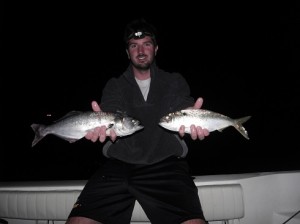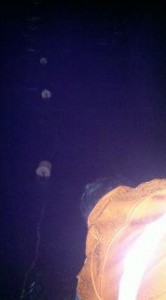Up until 2011, pogies had eluded me for years. How to catch pogies had remained a mystery the greater part of my time on Earth.
Well I am happy to report that I am no longer puzzled by this mysterious bait fish! At least for the moment...
Live pogies make great bait for striped bass and bluefin tuna. Early in the tuna season, you may pay up to $60 for a dozen live pogies-granted of course the pogie guy is able to catch enough the night prior to your tuna trip.
If you plan on going tuna fishing often, that $60 can add up quickly. If you have the time, then why not devote a night to catching your own live menhaden?

So far we have had our best success gill netting pogies well after the sun goes down, in harbor and creek channels where we have heard of pogies being consistently sighted and caught.
We use a pretty sturdy, well made 100 foot long, 10 foot deep gillnet. The net has a 3.5 inch stretch mesh, which is a good all around size for catching the adult menhaden and occasional shad we routinely encounter.
Don't forget that a special gill net permit is required in Massachusetts for gill nets longer than 50 feet.
Setting and retrieving the net is a two man operation. With the boat in gear, moving forward at a tube and worm trolling pace, the net is gradually fed over the gunnel. It's important to play the wind and current in a manner that results in the net extending to its full length. In other words, sometimes the wind and current cause the net to bundle up on itself-seriously impacting the net's fish catching ability.
Once the gill net is set we tie it off to a cleat on the stern of the Miss Loretta. We drift with the net through the area where we suspect pogies to be residing, carefully watching the gill net buoys for movement. Once the buoys begin bouncing around, or even better, completely disappear from sight, we retrieve the gill net, which is now hopefully loaded up with healthy adult menhaden.
I've found that removing the pogie from the net while the fish is still in the water is easier and less damaging to the pogie. Just be sure to not drop the precious bait back into the water.

As mentioned before, we have had our best pogie success when fishing creek and harbor channels, and more specifically, the edges of such channels. A perfect gill net set is one that takes the net across the channel, or down the edge of the channel.
It is also possible to use your sonar to locate a pogie filled section of a channel. On my color Humminbird unit, pogies mark as blue and green blotches. A quick gill net set through an area with lots of blue and green marks usually results in bouncing buoys.
One problem we have run into has been marking pogies on the sonar that are holding deeper than 10 feet. Because our gill net only covers the top 10 feet of the water column, it is impossible for us to catch pogies swimming deeper than 10 feet. Fortunately, at some point during the course of the night (usually between 2am - 4am) the pogies venture closer to the surface, and subsequently get caught up in the net.
Another interesting observation we have made is that pogies tend to travel independently, or in small groups of twos and threes at night. Striped bass often exhibit this same sort of behavior. These fish are "shoaling" or spread out amongst a large general area. I'd imagine that these pogies are on the feed during the night, filtering out whatever they can from the harbor or bay. Then, when the sun rises, they ball back up into tight schools for protection.
Gill netting pogies is a bit wet and messy but can be a lot of fun. If you are like me, you will find yourself eying those little buoys with the same intensity you watch a kite bait. And then, out of nowhere a buoy goes down-fish on!
Good luck pogie fishing!
Ryan
As always comments are encouraged and appreciated!
Follow My Fishing Cape Cod on Facebook by click here.


Ryan,
Great website. Can you give me an idea of a couple locations and what time of the year you fish for pogies.
Thanks, Joe L.
Thanks Joe!
A lot of the harbors from Duxbury to Chatham will hold pogies throughout the season. We’ve done best during late summer/early fall.
Have you checked out this video? https://myfishingcapecod.com/gill-netting-pogies-2/
It may help as well.
If you need more detailed info just post a topic within the forum or shoot me an email at [email protected]
Thanks!